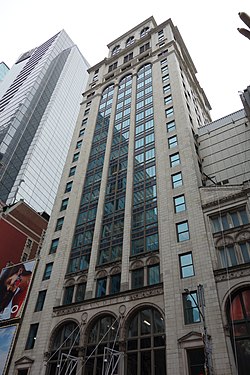
42nd Street is a major crosstown street in the New York City borough of Manhattan, spanning the entire breadth of Midtown Manhattan, from Turtle Bay at the East River, to Hell's Kitchen at the Hudson River on the West Side. The street hosts some of New York's best known landmarks, including the headquarters of the United Nations, the Chrysler Building, Grand Central Terminal, the New York Public Library Main Branch, Times Square, and the Port Authority Bus Terminal.
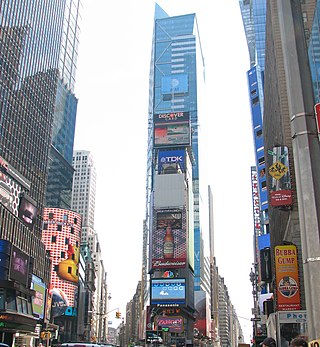
One Times Square is a 25-story, 363-foot-high (111 m) skyscraper on Times Square in the Midtown Manhattan neighborhood of New York City. Designed by Cyrus L. W. Eidlitz in the neo-Gothic style, the tower was built in 1903–1904 as the headquarters of The New York Times. It takes up the city block bounded by Seventh Avenue, 42nd Street, Broadway, and 43rd Street. The building's design has been heavily modified throughout the years, and all of its original architectural detail has since been removed. One Times Square's primary design features are the advertising billboards on its facade, added in the 1990s. Due to the large amount of revenue generated by its signage, One Times Square is one of the most valuable advertising locations in the world.

The Chanin Building, also known as 122 East 42nd Street, is a 56-story office skyscraper in Midtown Manhattan in New York City. It is on the southwest corner of 42nd Street and Lexington Avenue, near Grand Central Terminal to the north and adjacent to 110 East 42nd Street to the west. The building is named for Irwin S. Chanin, its developer.

The New Amsterdam Theatre is a Broadway theater at 214 West 42nd Street, at the southern end of Times Square, in the Theater District of Manhattan in New York City. One of the first Broadway venues to open in the Times Square neighborhood, the New Amsterdam was built from 1902 to 1903 to designs by Herts & Tallant. The theater is operated by Disney Theatrical Productions and has 1,702 seats across three levels. Both the Beaux-Arts exterior and the Art Nouveau interior of the building are New York City landmarks, and the building is on the National Register of Historic Places.
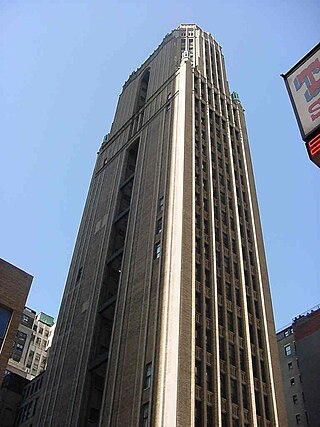
The Bush Tower is a skyscraper in the Midtown Manhattan neighborhood of New York City, just east of Times Square. Designed by Frank J. Helmle and Harvey Wiley Corbett of the firm Helmle & Corbett, the building occupies a plot at 130–132 West 42nd Street between Broadway and Sixth Avenue.
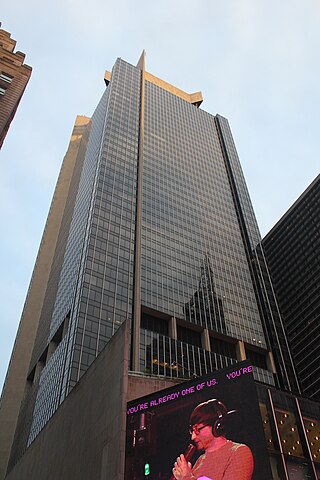
One Astor Plaza, also known as 1515 Broadway and formerly the W. T. Grant Building, is a 54-story office building on Times Square in the Theater District of Midtown Manhattan in New York City. Designed by Der Scutt of Ely J. Kahn & Jacobs, the building was developed by Sam Minskoff and Sons. One Astor Plaza occupies a site bounded by Broadway to the east, 45th Street to the north, Shubert Alley to the west, and 44th Street to the south. The building is named for the Hotel Astor, which had occupied the site from 1904 to 1967. SL Green Realty and Allianz own One Astor Plaza, which as of 2022 serves as the headquarters for Paramount Global.

The Lyric Theatre is a Broadway theater at 214 West 43rd Street in the Theater District of Midtown Manhattan in New York City. Opened in 1998, the theater was designed by Richard Lewis Blinder of Beyer Blinder Belle, in collaboration with Peter Kofman, for Garth Drabinsky and his company Livent. The Lyric Theatre was built using parts of two former theaters on the site: the Apollo Theatre, built in 1920 to a design by Eugene De Rosa, and the old Lyric Theatre, built in 1903 to a design by Victor Hugo Koehler. The theater contains 1,622 seats across three levels and is operated by Ambassador Theatre Group (ATG). The theater building is owned by the city and state governments of New York and was developed by New 42nd Street.

The Todd Haimes Theatre is a Broadway theater at 227 West 42nd Street in the Theater District of Midtown Manhattan in New York City. Built in 1918, it was designed by George Keister and developed by brothers Edgar and Archibald Selwyn, for whom the theater was originally named. The theater is owned by the city and state governments of New York and leased to New 42nd Street. It has 740 seats across two levels and is operated by Roundabout Theatre Company.
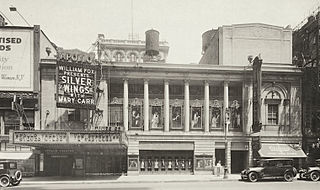
The Times Square Theater is a former Broadway and movie theater at 215–217 West 42nd Street in the Theater District of Midtown Manhattan in New York City, near Times Square. Built in 1920, it was designed by Eugene De Rosa and developed by brothers Edgar and Archibald Selwyn. The building, which is no longer an active theater, is owned by the city and state governments of New York and leased to New 42nd Street.
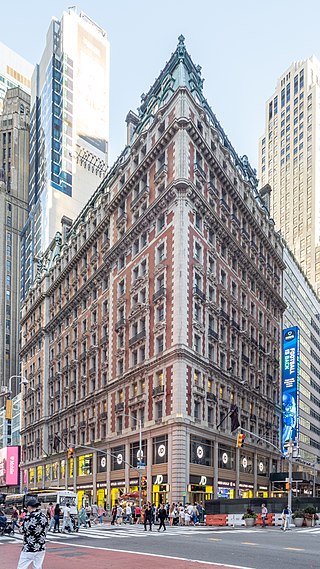
The Knickerbocker Hotel is a hotel at Times Square, on the southeastern corner of Broadway and 42nd Street, in the Midtown Manhattan neighborhood of New York City. Built by John Jacob Astor IV, the hostelry was designed in 1901 and opened in 1906. Its location near the Theater District around Times Square was intended to attract not only residential guests but also theater visitors.
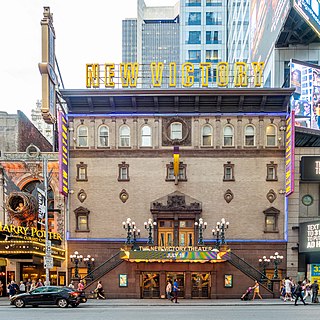
The New Victory Theater is a theater at 209 West 42nd Street in the Theater District of Midtown Manhattan in New York City, near Times Square. Built in 1900 as the Republic Theatre, it was designed by Albert Westover and developed by Oscar Hammerstein I as a Broadway theater. The theater has been known by several names over the years, including the Belasco Theatre, Minsky's Burlesque, and the Victory Theatre. The theater is owned by the city and state governments of New York and leased to nonprofit New 42, which has operated the venue as a children's theater since 1995. The New Victory presents theater shows, dance shows, puppet shows, and other types of performance art shows from all around the world.

330 West 42nd Street, also the McGraw-Hill Building and formerly the GHI Building, is a skyscraper in the Hell's Kitchen neighborhood of Manhattan in New York City. Designed by Raymond Hood and J. André Fouilhoux in a mixture of the International Style, Art Deco, and Art Moderne styles, the building was constructed from 1930 to 1931 and originally served as the headquarters of McGraw-Hill Companies. The 485-foot-tall (148 m) building contains 33 stories.

Times Square Tower, also known as 7 Times Square, is a 48-story office skyscraper at the southern end of Times Square in the Midtown Manhattan neighborhood of New York City. Located on the city block bounded by Broadway, 42nd Street, Seventh Avenue, and 41st Street, the building measures 724 feet (221 m) tall. The building was designed by David Childs of Skidmore, Owings & Merrill and developed by Boston Properties. The site is owned by the New York City Department of Citywide Administrative Services, though Boston Properties and Norges Bank have a long-term leasehold on the building.
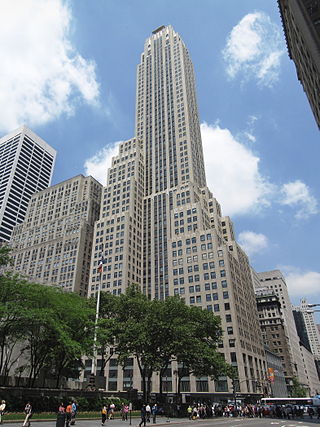
500 Fifth Avenue is a 60-story, 697-foot-tall (212 m) office building on the northwest corner of Fifth Avenue and 42nd Street in Midtown Manhattan, New York City. The building was designed by Shreve, Lamb & Harmon in the Art Deco style and constructed from 1929 to 1931.

The Liberty Theatre is a former Broadway theater at 234 West 42nd Street in the Theater District of Midtown Manhattan in New York City. Opened in 1904, the theater was designed by Herts & Tallant and built for Klaw and Erlanger, the partnership of theatrical producers Marc Klaw and A. L. Erlanger. The theater has been used as an event venue since 2011 and is part of an entertainment and retail complex developed by Forest City Ratner. The theater is owned by the city and state governments of New York and leased to New 42nd Street. Brookfield Asset Management, which acquired Forest City in 2018, subleases the venue from New 42nd Street.

3 Times Square, also known as the Thomson Reuters Building, is a 30-story skyscraper at Times Square in the Midtown Manhattan neighborhood of New York City. Located on Seventh Avenue between 42nd and 43rd Street, the building measures 555 feet (169 m) to its roof and 659 feet (201 m) to its spire. The building was designed by Fox & Fowle and developed by Rudin Management for news-media company Reuters. The site is owned by the New York City Economic Development Corporation, though Rudin and Reuters have a long-term leasehold on the building.

The Empire Theatre is a former Broadway theater at 234 West 42nd Street in the Theater District of Midtown Manhattan in New York City. Opened in 1912, the theater was designed by Thomas W. Lamb for the Hungarian-born impresario A. H. Woods. It was originally named for female impersonator Julian Eltinge, a performer with whom Woods was associated. In 1998, the building was relocated 168 feet (51 m) west of its original location to serve as the entrance to the AMC Empire 25, a multiplex operated by AMC Theatres, which opened in April 2000.

The Anco Cinema was a former Broadway theatre turned cinema at 254 West 42nd Street, between 7th and 8th Avenues in Manhattan, New York City. It opened in 1904 and was originally named the Lew Fields Theatre. It continued to operate as a playhouse under various names until it was converted into a movie theatre in 1930. Its block was famous for its concentration of Broadway theatres turned cinemas. After World War II, the street declined and the Anco Cinema eventually became a pornography venue. It closed as a cinema in 1988 and was gutted for retail use. The building was demolished in 1997.

The Sam H. Harris Theatre, originally the Candler Theatre, was a theater within the Candler Building, at 226 West 42nd Street, in the Theater District of Midtown Manhattan in New York City. Opened in 1914, the 1,200-seat theater was designed by Thomas W. Lamb and built for Asa Griggs Candler, who leased it to George M. Cohan, Sam H. Harris, and George Kleine. Although the theater was intended to host both movies and legitimate Broadway productions, it functioned exclusively as a movie theater after 1933. The theater's auditorium was demolished by 1998. The only remnant of the former theater is its 42nd Street facade, which has been used by the Madame Tussauds New York museum since 2000.

5 Times Square is a 38-story office skyscraper at the southern end of Times Square in the Midtown Manhattan neighborhood of New York City. Located on the western sidewalk of Seventh Avenue between 41st and 42nd Street, the building measures 575 feet (175 m) tall. The building was designed by Kohn Pedersen Fox Associates (KPF) and developed by Boston Properties for Ernst & Young (EY). The site is owned by the New York City Economic Development Corporation, though David Werner and RXR Realty have a long-term leasehold on the building.
